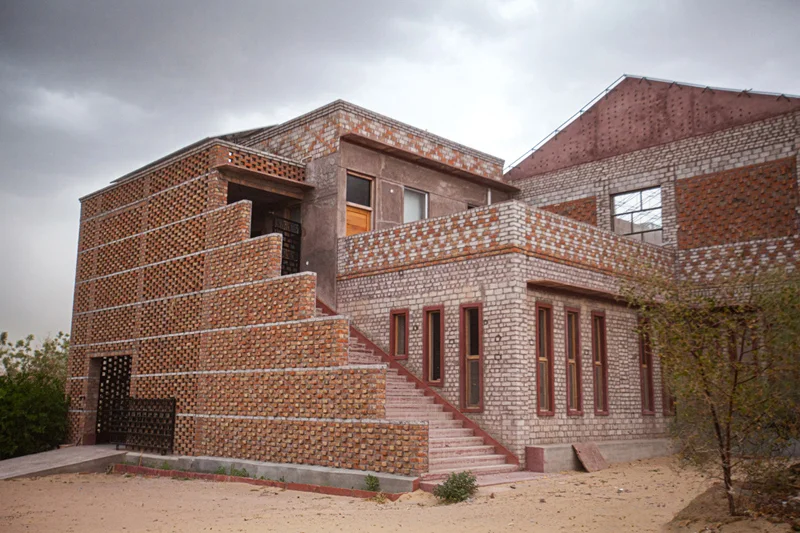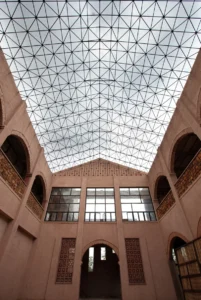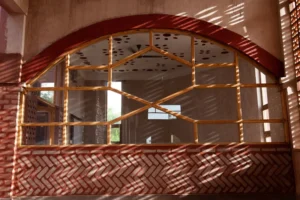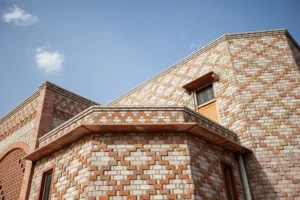
Amid the unforgiving expanse of western Rajasthan, where the Thar Desert’s fierce grasp subjects the land to a  relentless cycle of scorching 52-degree Celsius summers and bone-chilling winters at zero, a visionary project emerged – the new abode of Urmul Desert Crafts. In the rustic embrace of Bajju village, a mere 70 kilometres from the international border on the western front, this architectural undertaking – brick by brick, person by person – defied the odds, epitomizing both resilience and ingenuity. This architectural experiment stands as a living tribute to eco-conscious design, a guiding light on the path to sustainable existence.
relentless cycle of scorching 52-degree Celsius summers and bone-chilling winters at zero, a visionary project emerged – the new abode of Urmul Desert Crafts. In the rustic embrace of Bajju village, a mere 70 kilometres from the international border on the western front, this architectural undertaking – brick by brick, person by person – defied the odds, epitomizing both resilience and ingenuity. This architectural experiment stands as a living tribute to eco-conscious design, a guiding light on the path to sustainable existence.
Each day of development here unfolded as the sun emerged from its slumber, tracing the silhouette of this building against the horizon. As the sun set, it cast the building’s shadow, a testament to the dreams, tenacity, and vigor of the UDC team. The dance of light and shadow united the sun and the building – much like the intertwining journey of these teams and desert artisans through their aspirations, setbacks, weariness, triumphs, anxieties, and hopes – each day a page in their remarkable narrative.
Providing over 10000 Sqft of inspiring working space, the structure, purposefully conceived for artisans, designers, and craft managers, is a sanctuary where the traditions of textile-based handicrafts – the intricate embroidery, the rhythmic weaving, the hues of natural dyeing, the timeless art of block printing, and the meticulous stitching – find solace and inspiration amidst the interplay of light, shadow, and architectural motifs.
This architectural marvel quietly emerged, showcasing a harmonious fusion of locally-sourced resources and traditional techniques. The material palette revolved around sustainability, with fly-ash bricks and local limestone as the primary building blocks. Seasoned wood from ship scrap found new life in doors, windows, and furniture, while waste metal was ingeniously repurposed. Cement plaster took a backseat, as natural plaster, blended with sheep wool fiber, ash, and seasoned cow dung, adorned the interior. The result? A stunning edifice with greater plaster strength, enhanced acoustics, and improved thermal insulation – a testament to the power of conscious design and ecological sensibilities.

Before embarking on this remarkable odyssey, the young architect Inder D Khanolkar immersed himself in the desert’s heart, seeking communion with the region’s architectural ethos and aesthetics. With smaller projects as his stepping stones, he drew inspiration from the delicate grace of soof and Sindhi embroidery, ingeniously weaving their essence into the building’s very fabric. Through an exquisite interplay of grey-red brickwork, the building’s façade and every exposed facet bear the intricate patterns and insignias of embroidery, honouring the rich cultural tapestry woven into the artisans’ lives.
Hailing from a quaint village in Nokha, Bikaner, Prakash Janagal emerged as the principal mason, leading the remarkable implementation of this architectural gem spread across two transformative years. In his career, this endeavor stands tall as the largest, most prestigious, and profoundly educative project he has undertaken. From a humble daily wage mason, Prakash’s ascent to the esteemed position of a respected general contractor in the area is a testament to his dedication and skill. His team embraced the challenge of crafting something truly unique, guided by sustainability principles, enriched by traditional design sensibilities and knowledge, and fueled by the prowess of local masonry. As the walls rose and the structure took form, a sense of pride enveloped them, knowing that their hands had meticulously created this masterpiece.
In this dance of past and present, local masons found themselves transformed into custodians of time-honoured  wisdom. With time-tested limestone techniques at the heart of the project, the art of plastering and wall finishes found its roots in the very essence of the land. Lime, painstakingly extracted and prepared onsite, breathed life into the building. They were entrusted with the knowledge and artistry of working with limestone in diverse formulations, fostering a sense of curiosity and exploration. But what truly captivated them was the revival of a long-forgotten traditional technique – the blending of limestone with natural sheep fibre for application. Their newfound expertise in limestone applications would ripple outward, leaving an indelible mark on other projects.
wisdom. With time-tested limestone techniques at the heart of the project, the art of plastering and wall finishes found its roots in the very essence of the land. Lime, painstakingly extracted and prepared onsite, breathed life into the building. They were entrusted with the knowledge and artistry of working with limestone in diverse formulations, fostering a sense of curiosity and exploration. But what truly captivated them was the revival of a long-forgotten traditional technique – the blending of limestone with natural sheep fibre for application. Their newfound expertise in limestone applications would ripple outward, leaving an indelible mark on other projects.
Beyond the confines of bricks and mortar, these efforts are a profound celebration of knowledge exchange and heritage preservation and a standing testament to the enduring spirit of collaboration between architects, masons, and artisans, coming together to create something extraordinary – a manifestation of sustainable architectural brilliance infused with the echoes of history.
In the heart of the Thar Desert, where the sands whisper ancient tales of resilience and beauty, Urmul Desert Crafts’ new headquarters stands as a testament to the transformative power of art, community, and unwavering human spirit. This is the cause for an unwavering dedication to the promotion of local masons and the revival of traditional techniques emerging as a guiding beacon. A testament to the transformative power of knowledge and skill, many masons and laborers found themselves embarking on a journey of learning and sustainability principles, redefining the horizons of their craft. This endeavor wasn’t solely about implementing an architectural feat; it blossomed into a veritable training ground and a living built-environment laboratory. The legacy of the UDC space reverberates far beyond its walls, inspiring artisans and practitioners alike to embrace the enduring allure of tradition and the boundless possibilities of innovation.